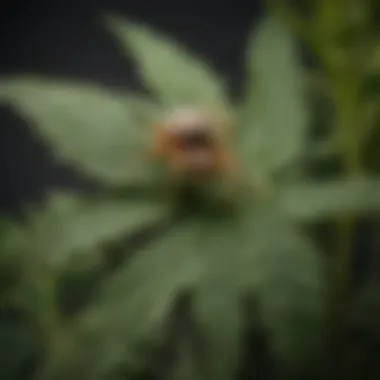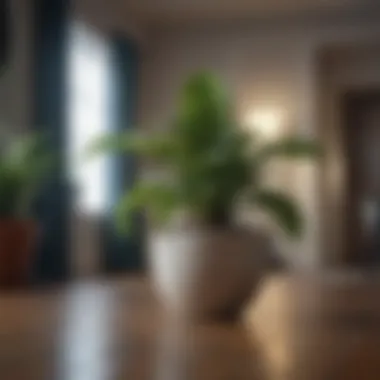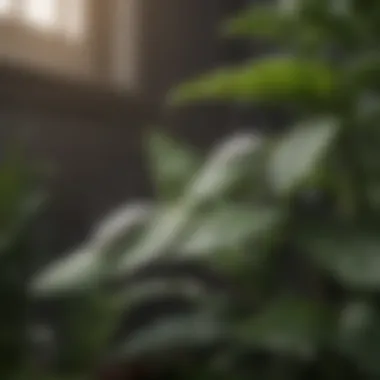Understanding and Managing Common Pests on Houseplants


Intro
Houseplants are more than mere decorations in our homes. They add life, improve air quality, and create a calming atmosphere. However, keeping these delightful green companions healthy can prove challenging, especially when pests invade. Understanding pests is crucial for any plant enthusiast. This article will delve into common pests that affect houseplants, describe their characteristics, and discuss effective control measures.
Recognizing these pests early can prevent significant damage to your plants. Ignoring the signs can lead to loss, not just of the plants, but also of the investment in time and resources. Whether you're a seasoned gardener or a new homeowner, this guide aims to provide valuable insights into managing pests effectively. The importance of maintaining a thriving indoor garden cannot be overstated, as it contributes to both aesthetic appeal and mental well-being.
Intro to Houseplant Pests
Managing pests on houseplants is a critical aspect of indoor plant care. Many people enjoy having houseplants. They can improve air quality and aesthetics in a home. However, pests can quickly become a significant issue, affecting the health and beauty of these plants. Understanding how to identify, prevent, and manage these pests can lead to a healthier indoor environment. Houseplant enthusiasts need to recognize the signs of pest problems early. This knowledge can save plants, time, and effort.
The Importance of Pest Management
Effective pest management is essential for maintaining plant health. Without attention, pests can multiply rapidly. They can cause noticeable damage to the foliage, stems, and even roots. The presence of pests can also stress plants, making them more susceptible to disease. By implementing a proactive pest management approach, homeowners can ensure their plants thrive in their indoor spaces. This includes regularly checking for pests and understanding which treatment methods are most effective.
Pest management also has broader implications. Healthy plants contribute to a positive atmosphere in homes. This can enhance overall well-being. Using proper techniques can make a significant difference in the life and vitality of houseplants. For instance, by understanding the pest cycle, one can apply preventive measures at the right times, reducing the need for chemical interventions later on.
Overview of Common Houseplant Pests
Different pests can invade houseplants, each with unique characteristics and behaviors. Some of the most common pests include:
- Aphids
- Spider Mites
- Mealybugs
- Scale Insects
- Whiteflies
- Fungus Gnats
Knowing these pests allows for more targeted prevention and treatment strategies. Each of these pests can cause various issues. For example, aphids drain sap from plants, weakening them over time. Conversely, spider mites can create unsightly webs, leading to decreased plant vigor. Additionally, recognizing the signs of an infestation helps in taking swift action.
In the subsequent sections, we will delve deeper into identifying each pest. We'll explore their physical characteristics, signs of infestation, and the potential damage they may cause. This detailed information is crucial for anyone interested in maintaining a robust collection of houseplants. By understanding these common pests, plant owners can develop effective strategies for prevention and treatment.
Identifying Common Pests
Understanding how to identify common pests is crucial for anyone who cares for houseplants. Early detection plays an important role in managing these pests effectively. Knowing the signs of infestation can help prevent further damage and keep plants healthy. This section will discuss various common pests, helping you develop skills needed to recognize and respond to these threats.
Aphids
Physical Characteristics
Aphids are small insects, often measuring about 1/8 inch or less. They typically have a pear-shaped body which can be green, black, or even white. Their soft bodies make them vulnerable but also allow them to reproduce rapidly.
A significant feature is their ability to form large colonies, usually found on the underside of leaves. This characteristic makes them a popular subject in discussions about pest management. If not addressed, their colonies can expand quickly, impacting the overall health of your plants.
Signs of Infestation
Identifying aphid infestations can be straightforward when looking for sticky residue called honeydew, which they excrete as they feed. Honeydew may lead to the growth of sooty mold, which appears as a black coating on leaves. Another sign includes distorted leaves or stunted growth, making early identification essential for maintaining plant health.
The distinct clusters of aphids on your plants significantly increase the urgency of treatment. Recognizing these signs early is beneficial because it allows for quicker intervention.
Potential Damage
Aphids feed on plant sap, weakening plants over time. This feeding can lead to yellowing leaves, wilting, and even plant death if not managed effectively. They also transmit viral diseases, adding another layer of concern for plant owners.
The main feature of aphids is their rapid reproduction rate. It can cause significant damage in a short time, making it imperative to use effective treatment methods when they are identified.
Spider Mites
Physical Characteristics
Spider mites are microscopic arachnids, typically less than 1/64 inch in size, and can appear as tiny, moving specks. Their most identifiable characteristic is their spider-like appearance and the presence of fine silk webbing on affected leaves.
This silk often indicates a severe infestation, making spider mites a relevant topic for pest management discussions. Understanding their characteristics can help in preventative measures against infestations.


Signs of Infestation
Signs of spider mite infestations include stippling or yellowing of leaves. Look for tiny webs on the undersides of leaves or the presence of fine dust on plant surfaces. Detecting spider mites early can prevent them from spreading.
Their rapid reproduction can overwhelm plants quickly, so recognizing these early signs is crucial for effective control.
Potential Damage
Spider mites cause damage by puncturing plant cells to feed. This feeding behavior leads to discoloration and can ultimately result in plant decline. Their ability to reproduce rapidly complicates treatment efforts, making it essential to monitor for signs regularly.
Mealybugs
Physical Characteristics
Mealybugs are easily identifiable due to their waxy, white coating and soft body structure. Their size is roughly 1/4 inch and they often cluster in groups on the stems and leaf joints of plants.
This unique appearance makes them a key pest to be aware of for home caregivers. Their waxy coating provides some protection, making identification critical for thorough treatment.
Signs of Infestation
Mealybugs often leave behind a sticky residue like aphids, along with cotton-like masses on plants. Observing your plants regularly for these signs can prevent larger infestations from taking hold.
Their distinctive white masses make them relatively easy to spot, emphasizing their importance in houseplant care.
Potential Damage
Mealybugs sap the nutrients from plants, leading to stunted growth and leaf drop. They can transmit plant diseases, compounding their damage potential. Their ability to form colonies can lead to severe consequences for plant health, highlighting the need for timely action when detected.
Scale Insects
Physical Characteristics
Scale insects can vary widely in appearance, from hard and bumpy to soft and waxy. They are usually small, resembling tiny bumps or scales that remain attached to plant surfaces.
This characteristic makes them often mistaken for plant parts rather than pests, which complicates early detection efforts. Understanding their differences is vital for effective plant care.
Signs of Infestation
The presence of scale on plant leaves and stems is a primary indicator of infestation. Dead plant tissues around infected areas or sticky honeydew can also signal their presence.
Being vigilant about inspecting plants for these features is crucial in maintaining their health and preventing further infestations.
Potential Damage
Like other sap-sucking insects, scale insects degrade plant vigor over time. Their feeding can lead to leaf drop and overall decline. Being able to identify and effectively treat scale infections is crucial for maintaining strong houseplants.
Whiteflies
Physical Characteristics
Whiteflies are small, moth-like insects with a distinctive white appearance due to their powdery wings. They tend to be found in clusters and are highly mobile, often fleeing when plants are disturbed.
This characteristic makes identifying them challenging. However, their resilience emphasizes the importance of knowing how to manage these pests.
Signs of Infestation
Whiteflies leave behind sticky excretions and can cause yellowing of leaves. Their legs may stick to the plant surfaces as they move. Observing your plants for these details is essential for early intervention efforts.
Recognizing these conditions can lead to proactive treatment strategies that enhance plant health.


Potential Damage
Whiteflies feed primarily on plant sap, causing direct damage. As they can also transmit diseases, their management is crucial. If not treated, whitefly infestations can lead to significant devastation for affected houseplants.
Fungus Gnats
Physical Characteristics
Fungus gnats are small, dark flies, usually about 1/8 inch in size. Their appearance can be similar to fruit flies, but they tend to be more attracted to damp soil conditions.
Due to their life cycle linked to moisture, these pests can represent a significant issue for indoor growers. They are worth studying for anyone passionate about maintaining houseplant health.
Signs of Infestation
A telltale sign of fungus gnats is adult flies hovering near the soil of potted plants. The presence of larvae in the soil can also indicate infestations. Monitoring for these signs can help in controlling the population and reducing damage.
Their distinct life cycle and habits provide insight into effective treatment strategies for indoor plants.
Potential Damage
While adult fungus gnats may not cause much harm, their larvae feed on plant roots, which can stunt growth and damage the plant. Recognizing both the adults and larvae helps in developing effective pest control measures.
Preventative Measures
Preventative measures are crucial for ensuring the health of houseplants. By taking proactive steps, homeowners can significantly reduce the likelihood of pest infestations. Recognizing that prevention is often more effective and less labor-intensive than treatment underscores its importance. Pest management starts with understanding the environment in which plants thrive. Proper techniques in watering, light exposure, humidity control, and routine inspections play pivotal roles in establishing a defensive strategy against pests.
Proper Watering Techniques
Watering techniques can greatly influence the health of houseplants. Overwatering is a common issue that not only suffocates roots but also encourages pests like fungus gnats. Properly aerating soil and ensuring good drainage can help prevent such complications. It is advisable to check moisture levels regularly before watering. This can be done using a simple finger test; insert a finger into the soil about an inch deep. If the soil feels dry, it’s time to water. If it’s still moist, wait a few days.
Optimal Lighting Conditions
Light is vital for plant health and can deter pests when managed correctly. Each plant species has specific lighting needs that, when met, can foster robust growth, making them less susceptible to infestations. Locations should be chosen carefully, avoiding areas with direct harsh sunlight or insufficient light. Use grow lights if natural sunlight is inadequate. Observing plant responses to their environment helps in adjusting light levels accordingly.
Maintaining Indoor Humidity
Humidity levels play a significant role in plant vitality. Most houseplants thrive in environments with a humidity level between 40% and 60%. Low humidity can stress plants, making them more vulnerable to pests. Utilizing humidifiers can help maintain these levels. Alternatively, you can group plants together to create a microclimate or place a tray of water near them to increase moisture in the air. Regularly monitoring humidity levels will also help achieve the ideal conditions for your plants.
Regular Inspection Routines
Regular inspections are essential in pest management. Setting up a routine where you check your plants weekly can help catch infestations early. Look under leaves and along stems to identify any signs of pests such as discoloration or webbing. This proactive approach allows for quicker response options, reducing the risk of extensive pest damage. Keeping a log of changes in your plant’s appearance can also aid in determining the effectiveness of preventive measures.
Effective Treatment Methods
Managing houseplant pests effectively is crucial for ensuring the health and longevity of your indoor plants. This section outlines several treatment methods that can be employed to combat infestations. Each method has its own benefits and considerations, helping homeowners choose the approach that best fits their situations.
Mechanical Control
Mechanical control involves physically removing pests or disrupting their environment. This method can be particularly effective for small infestations. Techniques usually include using a water spray to dislodge pests or manually removing visible insects with a soft cloth. Sticky traps can also be used to catch flying pests, like whiteflies.
The primary advantage of mechanical control is that it does not involve chemicals, making it a safer option for households with pets or young children. However, its limitations lie in the fact that it may not be sufficient for severe infestations.
Chemical Control Options
Chemical controls can effectively target a wide range of pests and typically provide quick results. It is essential to understand the different types available for informed decision-making.
Organic Pesticides


Organic pesticides are derived from natural sources and are designed to control pests while minimizing harm to the environment. They often include substances like neem oil or insecticidal soap. One key characteristic of organic pesticides is their lower toxicity compared to traditional chemicals. This makes them a more favorable choice for many plant enthusiasts who seek environmentally friendly solutions.
A unique feature of organic pesticides is that they often decompose quickly, thus minimizing residue. However, their effectiveness can vary based on concentration and application methods, which may lead to some dissatisfaction in rapid pest control.
Traditional Pesticides
Traditional pesticides contain synthetic chemicals that can provide powerful control over pests. They tend to work quickly and are generally more effective for larger infestations. One key characteristic of traditional pesticides is their long shelf-life, which can be advantageous for occasional use.
The unique feature here is the range of formulations available, allowing users to choose based on their specific pest issue. However, concerns over human and environmental safety remain. Users must sufficiently read and follow instructions to mitigate the risks involved with chemical exposure.
Natural Remedies
Natural remedies are increasingly popular among houseplant enthusiasts. They offer a more holistic approach to pest control without relying heavily on chemicals.
Homemade Solutions
Homemade solutions can include mixtures of common household items like water, soap, and oils. This approach caters to those who prefer to minimize expenses and chemical use. One notable characteristic of homemade solutions is their customization potential, allowing users to create mixtures based on personal efficacy. These solutions are usually easy to prepare and use.
However, effectiveness can greatly vary, and certain mixtures may harm plants if not properly diluted. Finding the right balance is essential for success.
Beneficial Insects
Introducing beneficial insects is a natural method that can significantly reduce pest populations. Predatory insects like ladybugs or lacewings target common houseplant pests, helping maintain balance within the indoor ecosystem. This method's primary advantage is its sustainability and environmental friendliness.
A unique feature of using beneficial insects is that they can continue to suppress pest populations as long as the environment is suitable. On the downside, this method may require patience as the beneficial insects establish themselves, and improper introduction can lead to further pest issues.
Monitoring and Follow-Up Care
Monitoring and follow-up care is a critical aspect of houseplant maintenance, especially when dealing with pests. Once treatment methods are applied, the need to observe changes in the plant's health becomes essential. Regular monitoring allows one to assess the effectiveness of pest control methods and ensures the plant's environment remains suitable for growth.
Through consistent observation, signs of recovery become evident. Noticing these signs contributes not only to the plant's restoration but also reinforces the gardener's confidence in the applied care measures.
Signs of Recovery
Recognizing when a plant is recovering from a pest infestation can be rewarding. Common signs include:
- New Growth: Healthy shoots or leaves emerging from the plant indicate its resilience. This is often a sign that the pest population has decreased.
- Improved Color: A shift from yellowing leaves back to vibrant greens implies that the plant is regaining its strength.
- Reduced Damage: The absence of new holes in leaves, or fewer visible pests suggests a successful management strategy.
It’s worth noting that recovery may not happen overnight. It requires patience and continued vigilance.
Ongoing Maintenance Practices
To ensure the longevity and health of houseplants after a pest problem, ongoing maintenance is vital. Key practices include:
- Regular Inspections: Set a routine schedule to check your plants closely. Look for signs of new pests or damage to catch issues early.
- Careful Watering: Avoid overwatering, as it can attract pests like fungus gnats. Allow the soil to dry between watering sessions for better plant health.
- Maintain Humidity Levels: Understand the humidity needs of your specific plants. Adjusting this can help deter certain pests and stimulate plant growth.
- Fertilization: Using a balanced fertilizer can strengthen plants, enhancing their ability to withstand infestations.
- Quarantine New Plants: If you bring in new plants, consider isolating them for a period. This will prevent potential pest spreading to your existing collection.
Maintaining successful houseplants involves more than just responding to pest problems; it’s an ongoing commitment to their health and environment.
In summary, monitoring behavior after treating pests and implementing ongoing care practices play a crucial role in maintaining vibrant, pest-free houseplants. By applying consistent attention and effort, one can enjoy a thriving indoor garden.
End
The conclusion section of this article highlights the essential aspects of managing houseplant pests effectively. Understanding pest management is not merely a necessity for any plant enthusiast but also crucial for sustaining the overall health of indoor plants. Through various points discussed in the article, it is evident how systematic identification, prevention, and treatment form the backbone of successful pest management.
Summary of Key Points
Firstly, recognizing different types of pests, such as aphids, spider mites, and mealybugs, is vital. Each of these pests has distinct physical characteristics, and knowing them helps in minimizing their impact on plants. Secondly, preventive measures, including proper watering techniques, optimal lighting conditions, and regular inspections, can significantly reduce infestation risks. Lastly, employing both mechanical and chemical treatments ensures pests can be effectively controlled when they appear.
"A proactive approach to plant health can prevent more serious issues down the line."
The significance of ongoing monitoring and follow-up care cannot be overlooked. This not only fosters an environment conducive to plant recovery but also enhances the overall aesthetic value of indoor spaces.
Encouragement for Future Care
Moving forward, it is crucial to remember that healthy plants contribute to a lively indoor atmosphere. Being attentive to your houseplants is key to maintaining their beauty and vitality.
As a plant caretaker, embracing continuous learning about plant care and pest management will further enhance your skills. Engage with communities on platforms like Reddit or Facebook to share experiences and gain new insights. Regularly update your strategies based on the latest knowledge and trends in pest management.
In summary, with diligent effort and informed practices, you can effectively manage plant pests. This yields not only thriving houseplants but also a more enriched and fulfilling experience as a gardener.















